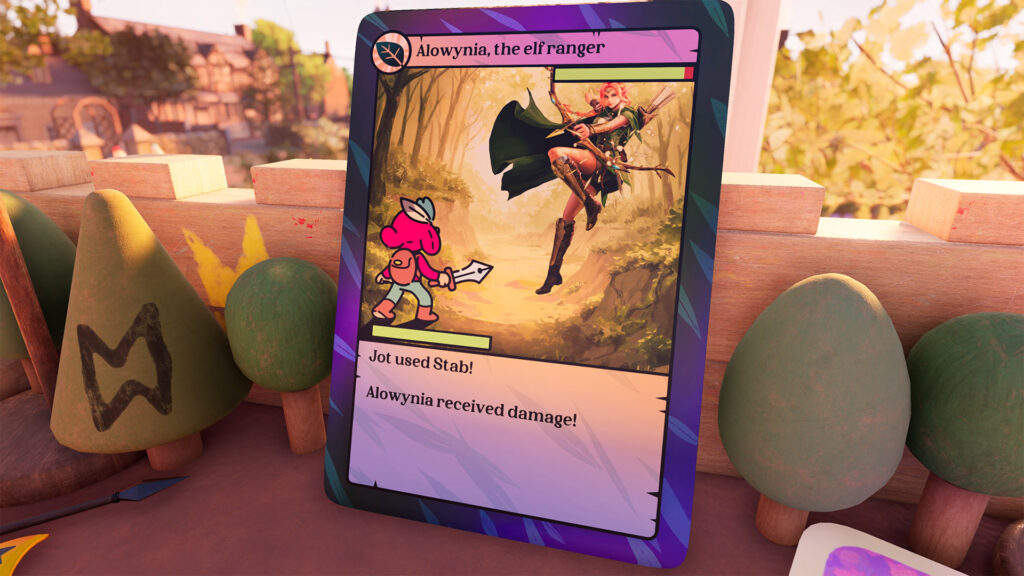In the vast landscape of indie games, The Plucky Squire stands out as a title that captures attention with its innovative design, genre-switching gameplay, and a charming storybook aesthetic. Developed by the creative minds at All Possible Futures and published by Devolver Digital, this adventure takes players on a journey through two distinct worlds—one inside the pages of a storybook and another in a 3D, real-world setting. Let’s dive into what makes The Plucky Squire a delightful yet concise experience.
A Tale of Two Worlds: 2D Puzzle-Solving Meets 3D Platforming
At the heart of The Plucky Squire lies its core mechanic: transitioning between 2D and 3D worlds. Players step into the shoes of Jot, a heroic figure from a storybook, whose mission is to stop the villain Humgrump from rewriting the story’s ending to claim victory for evil. The game begins with a familiar top-down, 2D perspective reminiscent of classic Zelda titles, complete with satisfying puzzles and feel-good combat controls. From the get-go, it’s clear that this 2D gameplay is smooth and polished, creating an almost nostalgic atmosphere for fans of older adventure titles.
As Jot journeys through the storybook world, the game surprises players by shifting to a 3D platforming perspective when he jumps out of the pages and into the “real world.” This sudden shift feels akin to Super Mario Odyssey, with Jot navigating around objects like coffee mugs and pens, suddenly shrunken to the size of an ant. The contrast between the flat, colorful illustrations of the storybook and the more realistic environments of the 3D world is striking, offering a fresh and visually captivating gameplay experience.

Seamless Genre Hopping
One of The Plucky Squire’s most innovative features is how it effortlessly hops between different genres. While primarily a 2D puzzle-solving adventure, there are elements of side-scrolling platforming, bullet-hell combat sequences, and even text-based interactions. These transitions are smooth and feel natural within the story, preventing the game from ever becoming monotonous.
For example, players may encounter sections where Jot must rewrite parts of the story by mixing and matching words in text-based puzzles. These moments aren’t just cute gimmicks but rather integral to advancing the narrative and solving key problems. Meanwhile, the platforming segments outside the book, with their cleverly designed levels and real-world obstacles, evoke a sense of exploration and curiosity that harkens back to classic 3D platformers.
A Visually Stunning Journey
It’s impossible to talk about The Plucky Squire without mentioning its breathtaking visuals. The game boasts a beautiful hand-drawn aesthetic inside the storybook, with vibrant colors, cartoonish characters, and delightful animation. Every page of the book feels alive, with dynamic environments and hidden secrets waiting to be discovered.
Once Jot leaps into the 3D world, the art direction shifts dramatically to a more realistic style, with highly detailed objects and environments that feel tangible and grounded in reality. The juxtaposition of these two art styles is masterfully executed, and it keeps the game visually engaging throughout its short runtime.
A Brief, Linear Adventure
Despite its charm and creativity, The Plucky Squire does have some limitations. The game is divided into nine chapters, and the entire adventure can be completed in roughly five hours. While the short playtime makes it a great pick for a casual weekend, some players may find the $30 price tag steep, given the game’s brevity.
The linearity of the game is another aspect that stands out. Much of the narrative is delivered through fairly straightforward dialogue sequences, which, while endearing, sometimes feel excessive. The story progresses in a predictable manner, without the deep branching paths or decision-making elements that more open-ended adventure games offer. While this helps to keep the focus on Jot’s journey, it also limits replayability and leaves certain segments feeling unnecessary.
The Gameplay Loop: Fun, But Repetitive
One of the game’s greatest strengths is its core gameplay mechanics—whether you’re slashing enemies with Jot’s sword in the 2D realm or jumping across platforms in 3D, the controls are tight, responsive, and enjoyable. Combat is simple but satisfying, and puzzle-solving feels intuitive. However, as you progress through the game, the variety of enemies and challenges doesn’t evolve significantly, which can lead to some repetition by the time you reach the final chapters.
Storybook Magic (What I Loved)
- Beautiful Art Direction: The hand-drawn 2D visuals are vibrant, and the transition to 3D is stunning. The contrast between the two styles keeps the experience fresh.
- Feel-Good Controls: Whether in 2D or 3D, the controls are responsive and intuitive, making both combat and platforming fun.
- Genre Variety: The game’s ability to hop between genres, from puzzle-solving to platforming, keeps it unpredictable and engaging.
- Charming World: The whimsical characters and imaginative environments create a delightful and relaxing experience.
A Short Story (Where It Falls Flat)
- Short Playtime: At around five hours, the game is short, especially given its $30 price tag.
- Limited Replayability: The linear story and minimal branching paths reduce the incentive to replay the game.
- Repetitive Combat: While initially fun, the combat mechanics don’t evolve much, leading to some monotony.
- Excessive Dialogue: Some sections of dialogue feel unnecessarily long, slowing down the pace of the adventure.
The Plucky Squire: The Plucky Squire is a charming, visually stunning adventure that combines clever genre-hopping mechanics with a heartfelt story. Though its short playtime and linearity may not appeal to everyone, its imaginative design and fluid gameplay make it a memorable experience. If you’re in the mood for a light, relaxing adventure that’s easy on the eyes and delivers a burst of creativity, this game is well worth a look—just be mindful of its relatively steep price for the short journey it offers. – Obsidian